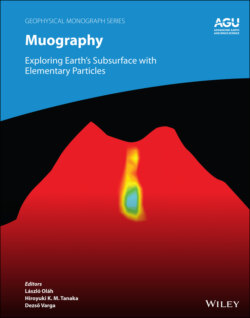Читать книгу Muography - Группа авторов - Страница 63
4.3 A CONCEPTUALIZATION OF VOLCANO ERUPTION FORECASTING WITH MUOGRAPHY
ОглавлениеOur study applies the concept that was developed by Nomura et al. (2020) with a few modifications due to the different experimental setup (e.g., slightly different detector orientation, improved angular resolution, increase of the number of MMOS modules from five to seven in March 2019 and from seven to ten in August 2019 during two system upgrade works, etc.): the inputs of ML techniques are fed with data extracted from seven muon flux images that were recorded on seven consecutive days. The prediction of the ML model is compared to an eruption label that is “1” if there was at least one eruption on the 8th day; otherwise the eruption label is “0.” Three regions are extracted from the daily muon flux images to measure the accuracy of eruption forecasting: (i) the activated Minamidake crater with 7×6 segments in the angular region of −0.1725 ≤ tan (θx) < –0.0115 and 0.1495 ≤ tan (θy) < 0.2875 shown by the solid rectangle in Fig. 4.2; (ii) the deactivated Showa crater with 4 × 5 segments in the angular region of –0.0115 ≤ tan (θx) < 0.0805 and 0.1265 ≤ tan (θy) < 0.2415 shown by the dashed rectangle in Fig. 4.2; and (iii) a surface region of Sakurajima volcano with 7×6 segments in the angular region of 0.1265 ≤ tan (θx) < 0.2875 and 0.0805 ≤ tan (θy) < 0.2185 shown by the dotted rectangle in Fig. 4.2. The averaged flux values are also calculated for these regions to feed the input to conventional ML techniques. Fig. 4.3 shows the average flux values for the three regions, with black error bars with 1σ standard deviation and the daily number of eruptions with gray impulses for the data collection period from 20 October 2018 to 29 June 2020. The muon flux images and average flux values are excluded from this analysis for those days on which the MMOS did not operate reliably or maintenance work was performed in SMO.
Significant change in the muon flux observed before or during the occurrence of eruption may reveal the underlying volcanological process. Consequently, it is worth investigating how the muon flux changes across the selected regions before and during the eruption. We selected 47 consecutive three‐day periods days in which the volcano did not erupt on the first two days and did erupt on the third day. Fig. 4.4 shows the average flux values for the three regions, divided by the average flux value measured on days when there is no eruption within ± 2 days. This quantity is called the averaged relative flux. As shown in Fig. 4.4a, the averaged relative flux increased by approx. 2.5σ standard deviations across the Minamidake crater one day before the eruption relative to the averaged relative fluxes measured on the other two days. The observed muon flux increase hints at the blasting of the magmatic plug located beneath the craters (Oláh et al., 2019b). The relative muon flux is decreased across the Showa crater below 2σ standard deviations (Fig. 4.4b). The role of this region in the eruption mechanism of Minamidake is an open question that should be addressed in future studies. As is expected, the averaged relative muon flux is around 1 across the Surface region, in which volcanological processes do not occur (Fig. 4.4c).
The data were organized as rows consisting of the seven daily muographic images or seven averaged flux values for the selected regions, and the corresponding eruption labels (“0” or “1”) for the eighth day. These rows were shuffled to avoid possible effects due to the change in the internal structure of crater region. The data set was divided into three smaller ones: (i) a training data set was selected for 394 days with 146 eruption days; (ii) a validation data set was selected for 110 days with 48 eruption days for tuning of hyperparameters; and (iii) a test data set was selected for 109 days with 56 eruption days for testing of tuned models and quantifying of the accuracy of eruption forecasting.
Figure 4.3 Average muon flux values are plotted with 1σ standard deviation (black error bars) for the erupting Minamidake crater (a), the deactivated Showa crater (b), and the Surface region of Sakurajima volcano (c) for the data collection period between 20 October 2018 and 29 June 2020. Daily number of eruptions of Minamidake are shown with gray impulses (a).
Figure 4.4 Averaged relative flux values for eruption days and the two days before that for the erupting Minamidake crater (a), the deactivated Showa crater (b), and the Surface region (c).
